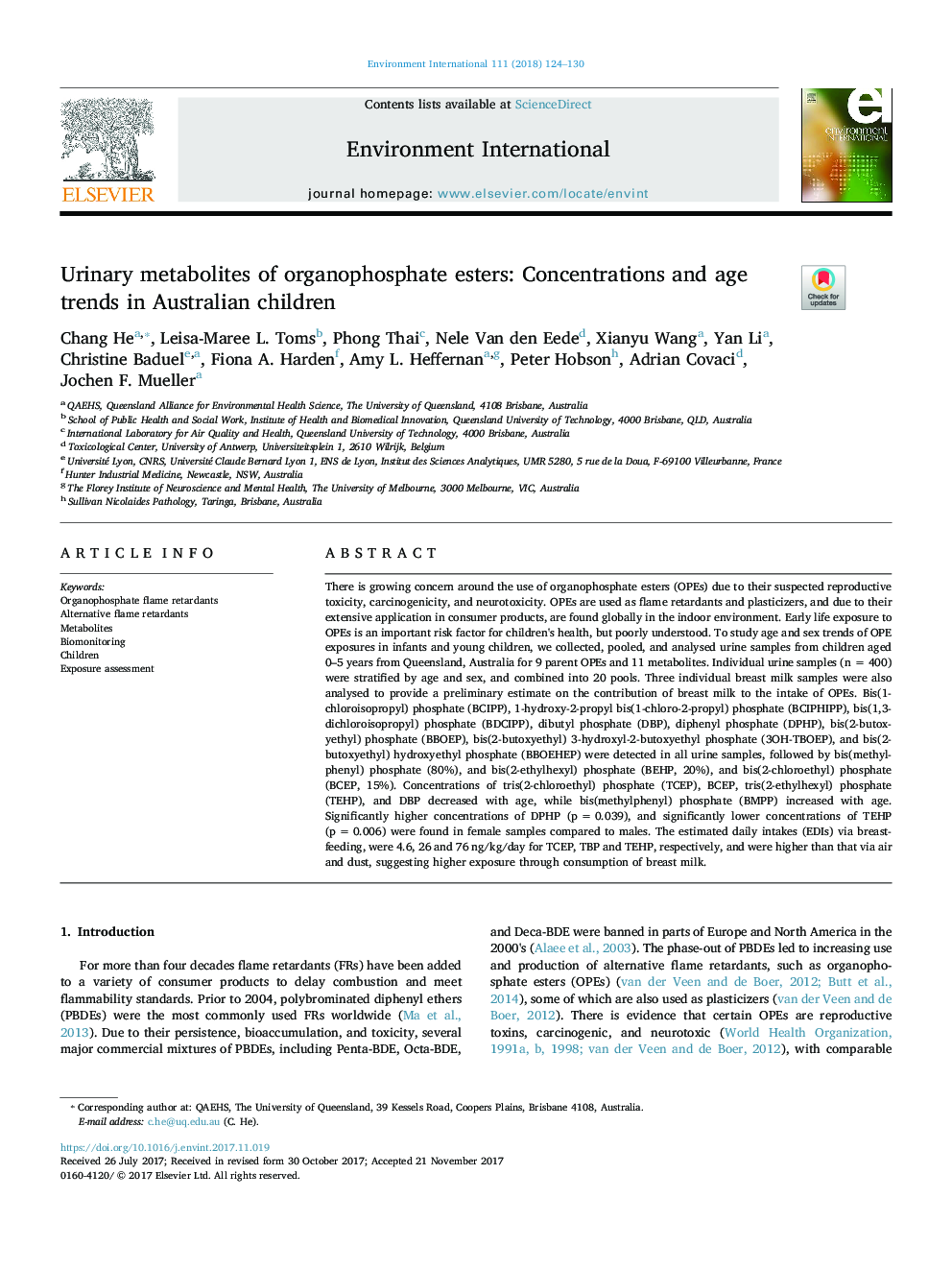| کد مقاله | کد نشریه | سال انتشار | مقاله انگلیسی | نسخه تمام متن |
|---|---|---|---|---|
| 8855486 | 1619019 | 2018 | 7 صفحه PDF | دانلود رایگان |
عنوان انگلیسی مقاله ISI
Urinary metabolites of organophosphate esters: Concentrations and age trends in Australian children
ترجمه فارسی عنوان
متابولیت های ادرار از اسیدهای ارگانوفسفره: غلظت و روند سنی کودکان استرالیا
دانلود مقاله + سفارش ترجمه
دانلود مقاله ISI انگلیسی
رایگان برای ایرانیان
کلمات کلیدی
بازدارنده های شعله ورتوفسفات، عقب اندازهای شعله ی جایگزین، متابولیت ها، بیومونیتوری، فرزندان، ارزیابی قرار گرفتن در معرض،
موضوعات مرتبط
علوم زیستی و بیوفناوری
علوم محیط زیست
شیمی زیست محیطی
چکیده انگلیسی
There is growing concern around the use of organophosphate esters (OPEs) due to their suspected reproductive toxicity, carcinogenicity, and neurotoxicity. OPEs are used as flame retardants and plasticizers, and due to their extensive application in consumer products, are found globally in the indoor environment. Early life exposure to OPEs is an important risk factor for children's health, but poorly understood. To study age and sex trends of OPE exposures in infants and young children, we collected, pooled, and analysed urine samples from children aged 0-5 years from Queensland, Australia for 9 parent OPEs and 11 metabolites. Individual urine samples (n = 400) were stratified by age and sex, and combined into 20 pools. Three individual breast milk samples were also analysed to provide a preliminary estimate on the contribution of breast milk to the intake of OPEs. Bis(1-chloroisopropyl) phosphate (BCIPP), 1-hydroxy-2-propyl bis(1-chloro-2-propyl) phosphate (BCIPHIPP), bis(1,3-dichloroisopropyl) phosphate (BDCIPP), dibutyl phosphate (DBP), diphenyl phosphate (DPHP), bis(2-butoxyethyl) phosphate (BBOEP), bis(2-butoxyethyl) 3-hydroxyl-2-butoxyethyl phosphate (3OH-TBOEP), and bis(2-butoxyethyl) hydroxyethyl phosphate (BBOEHEP) were detected in all urine samples, followed by bis(methylphenyl) phosphate (80%), and bis(2-ethylhexyl) phosphate (BEHP, 20%), and bis(2-chloroethyl) phosphate (BCEP, 15%). Concentrations of tris(2-chloroethyl) phosphate (TCEP), BCEP, tris(2-ethylhexyl) phosphate (TEHP), and DBP decreased with age, while bis(methylphenyl) phosphate (BMPP) increased with age. Significantly higher concentrations of DPHP (p = 0.039), and significantly lower concentrations of TEHP (p = 0.006) were found in female samples compared to males. The estimated daily intakes (EDIs) via breastfeeding, were 4.6, 26 and 76 ng/kg/day for TCEP, TBP and TEHP, respectively, and were higher than that via air and dust, suggesting higher exposure through consumption of breast milk.
ناشر
Database: Elsevier - ScienceDirect (ساینس دایرکت)
Journal: Environment International - Volume 111, February 2018, Pages 124-130
Journal: Environment International - Volume 111, February 2018, Pages 124-130
نویسندگان
Chang He, Leisa-Maree L. Toms, Phong Thai, Nele Van den Eede, Xianyu Wang, Yan Li, Christine Baduel, Fiona A. Harden, Amy L. Heffernan, Peter Hobson, Adrian Covaci, Jochen F. Mueller,
